Jason Schneider
the Camera Collector
Everyone from the Swiss to the East Germans got into the act,
but Japanese camera makers like Konica dominated the field
By Jason Schneider
Konica Auto-Reflex: Half Frame or Full Frame at the flick of a switch!
The Konica Auto-Reflex of 1966 (known as the Autorex in Japan) was the first truly successful auto-exposure SLR in the world in terms of its impact in the marketplace, and its mechanical reliability (the 1959 Savoyflex III from France was technically the first AE SLR, employing a Prontor leaf shutter and selenium-cell-controlled, shutter-priority metering system, but it was trouble prone and not very successful). What sometimes gets lost in the sauce is that Auto Reflex also has the remarkable ability to switch between full (24x36mm) and half-frame (18x24mm) formats at any time (!) a feature Konica pioneered in the Konica IIIM rangefinder camera in 1959. The Auto-Reflex has an external CdS cell to the right of the lens that controls a trap-needle type, shutter-priority autoexposure system, a feature of all Konica SLRs until the series finished in 1985. The Copal Square vertical travel metal focal-plane shutter provides speeds of 1/25-1/400 sec in automatic mode and 1-1/1000 sec in manual match-needle-metering mode, and the camera has a fixed pentaprism and a single stroke wind lever. Less than two years later, the Auto-Reflex evolved into the through-lens- (TTL) metering Autoreflex T, alas without the half frame option. The T was the camera that established Konica as a major SLR maker from the late ‘60s to the late ‘70s. Though it’s a historically important camera that is not too common in this country, the Konica Auto-Reflex is often quite reasonably priced when you find them, and they’ll accept all Konica AR bayonet-mount lenses. Approximate used price: Body only , $150-$175; with 52mm f/1.8 Konica Hexanon AR lens, $250.
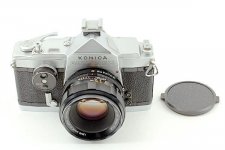 `
`
Konica Autorex of 1965 with 52mm f/1.8 Hexanon lens. Sold as the Auto-Reflex in the U.S. it was the world's first focal plane shutter autoexposure SLR, but it was also unique in being able to switch between full frame and half frame format at any time. Note non-TTL external CdS cell in round housing on the front.
Alpa Half Frame Models
Alpa was the name used for a series of high-end 35mm SLRs virtually hand assembled by Pignons S.A., a small artisanal Swiss company that made pinions for the Swiss watch industry. Based on a pre-war design penned by Jacques Bogobolsky (aka Bolsky) who famously designed the 16mm Bolex movie camera and various Bolsey 35s, the Alpa had a reputation for elegance precision, and exclusivity. It featured a removable back, a horizontal cloth focal plane shutter with speeds of 1/1000 sec plus B, and a ratcheted front facing film advance lever that you grab from the front and swing to the right. Like the Exakta, the Alpa’s shutter release is in the front of the camera where it can be conveniently coupled to the lens to provide external auto aperture stop-down when you press the release. The Alpa 9d of 1964 introduced a pentaprism for eyelevel viewing. It was one if the first SLRs with built-in CdS TTL metering, and the first to position the meter cells on the sides the eyepiece, a solution adopted by most other SLR makers. Alpa made a total of 3710 9d’s in various finishes including a very small number of half frame units before production was discontinued in 1969. The half frame models were basically modified full frame models with their film apertures and viewfinders masked down for the smaller format, and their frame counters suitably modified
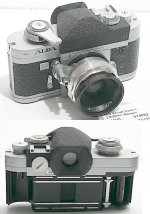
Front and rear views of half frame Alpa 9d. The post Swiss made 35mm SLRs were crafted in small quantities and half frame models are rare and pricey.
The Alpa 10d of 1968 added a non-rotating shutter speed dial, a second meter needle and index visible through a window in the accessory shoe, and other metering improvements. Out of the total production of 2540 10d’s 27 were made in half frame format before the model was phased out in 1974. The Alpa 11 series included 11 (!) minor variants. The Alpa IIe (with lighted metering arrows) commenced production in 1971 and was phased it out in 1975, with a total production of 1228 units, only 4 of which were half frame. The 11 el of 1972 (which indicated correct exposure by lighting up both metering arrows) had a total production run of 1163 units including 33 in half frame format when production ceased in 1976. Finally, the 11z, the last Swiss made Alpa (later Alpas, such as,the Si 2000, were made in Japan by Cosina) had a single shutter speed of 1/60 sec for electronic flash and a total production from 1977-1979 of 96 units, all in half frame format.
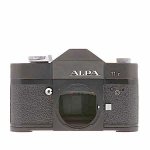
Alpa 11 z: The last Swiss made Alpa it was special a half frame model as you can see and it a single shutter speed of 1/60 sec. Only 96 were made!
All Swiss Alpas were turned out in very small quantities and perhaps no more than 40,000 were made in total. That’s why the half frame models are extremely rare and stratospherically priced, starting in the 5-figure range.
Alpa did not make its own lenses but Kern of Switzerland, Enna, Old Delft, Angenieux, Schneider, Schacht, and Kinoptic were happy to oblige. The Swiss Alpa was unusual in having a much shorter lens-to-film-plane (flange focal) distance than most 35mm SLRs, a key to its longevity and its optical flexibility.
Pentax half frame SLRs: One-off and production
Was there really a half frame Pentax? In fact, there were 2, but only one was manufactured entirely by Asahi Optical Co. The mysterious Pentax KX Half Frame was evidently a one-off modified KX, possibly created by a talented camera tech named Klinger. To quote from a May 2016 query posted on PentaxForums.com, “I snared this unicorn at the Pasadena Camera Show this past weekend; the seller got it from an estate sale on rubylane.com. It's got a modified film gate, masked-off viewfinder, a regeared film advance, and a handwritten 72-frame insert for the frame counter. Beneath the gate is inscribed MODIFIED BY KLINGER, and there are other inscriptions. Tell me what you know!” Well, to coin a phrase, “sjeffg” answered his own question, and to the best of my knowledge no further info on the camera’s provenance has emerged. For the record the Pentax KX, introduced in 1975, was a downsized bayonet mount TTL metering SLR with features paralleling those of the Pentax Spotmatic.
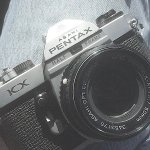
Pentax KX Half Frame: Yes, it exists and even has a nameplate, but it was evidently the work of a talented machinist and not a product of Asahi Optical Co,
The Pentax MF is the real thing, a genuine factory-made limited production half frame SLR loosely based on the Pentax ME that was evidently intended for medical imaging. To quote a Sept. 2009 posting on the Pentax Forums by Paul Ewins of Melbourne, Australia, “The Pentax MF and MF-1 are probably closer to the ME in features but are different enough to be their own thing. The most noticeable thing is the little hump on the prism where the hot shoe normally sits but as you can see from the top view the shutter speeds and exposure compensation are both different. As mentioned, they both have FP sync sockets. I have one MF with the data back pins and one without, so I don't know whether that was an option or a newer/later version. The MF is half frame, while the MF-1 is full frame and of course they have the same hump in the focusing screen as the MX Medical. And since the MF is half frame the frame counter has a 0, 4, 8, 12 sequence up to 72 instead of the usual sequence of 0, 2, 4 ,6… up to 36. The 0, 40, 48, and 72 are marked in orange instead of the usual 0, 20, 24 and 36.” The a,b,c,d and A,B,C,D exposure compensation scales and the “1/4 sec” setting on the exposure mode dial are, um, interesting, but since nobody has come up with a manual we can only surmise their exact functions.
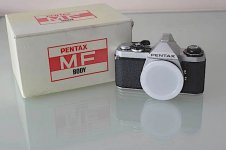
Pentax MF half frame camera with original box; Loosely based on the best selling Pentax ME, it's very pretty and a collector's prize
For the record, the compact full frame Pentax ME introduced in 1976 was a very successful K-mount, aperture priority AE SLR with a vertical travel metal focal plane shutter with speeds from 8 to 1/1000 sec, and X sync at 1/100 sec There was no shutter dial, and the camera couldn’t be used in manual mode, except at the B and 1/100 sec settings. The ME provided TTL, open aperture, center-weighted metering that was activated by a slight pressure on the release button. How many Pentax MF half frame SLRs were made, and what are they worth? Hard figures are elusive, but I ‘d surmise that total production was in the low hundreds, and that selling prices would be in the low thousands.
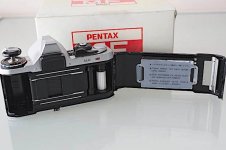
Open back view of Pentax MF shows half frame 18 x 24mm film gate aperture, and ingenious multi-slotted take-up spool.
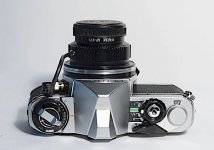
Pentax MF top view shows control array similar to full frame Pentax ME. Note odd "abcd ABCD" exposure compensation dial and "1/4" sec exposure mode.
The Praktica L2 half frame
This East Germany beauty was a half frame variant of the spartan meter-less Praktica L2 made in large quantities (161,240 cameras) from late 1975 to early 1980. It had the same basic features as the standard full frame L2, including an M42 screw mount, an easy loading system, fixed eyelevel pentaprism finder, instant return mirror and a single stroke wind lever. The half frame version of the L2, used mostly by police departments for shooting mug shots, has a single, fixed, X-sync shutter speed of 1/125 sec (unlike the full frame version whose mechanically controlled, vertical travel, metal focal plane shutter has speeds of 1-1/1000 sec plus B) a Fresnel finder screen with central microprism that was masked down to the 18 x 24mm format using black fabric (!), a modified rewind knob, and an auto-zeroing frame counter. The half frame L2 shown was fitted with a 50mm f/2,8 Meyer Domiplan lens (a mediocre triplet) and sold for a paltry 120 euros. Nobody knows for sure how many of these gems were produced, but production numbers were probably fairly low given the limited market and its single-speed shutter that would be off-putting to everyday shooters. You can snag a regular (quite nice) full frame Praktica L2 complete with sketchy Domiplan lens for around 75 bucks; a rare half frame L2 would probably run 3-4 times that.
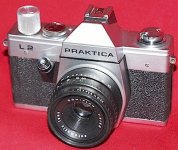
Praktica L2: The standard full frame version had a single stroke wind lever but this half framer had a tall wind knob and a single 1/125 sec shutter speed.
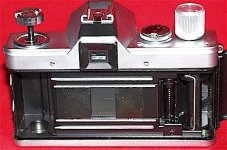
Open back view of Praktica L2 half frame shows 18 x 24mm film gate aperture, vertical metal blade focal plane shutter, and quick loading take-up spool.
Half frame Exas? Yep!
The Exa 1a of 1964 added a wind lever, more modern styling licks, and a shutter speed dial (instead of a stick in a slot!) under the rewind knob to the Exakta’s little sister. However, its distinctive under the mirror “bread box” shutter with speeds of 1/30, 1/60, 1/125, and 1/175 sec plus B, Ekakta bayonet mount, and interchangeable waist level and prism finders remained the same. Well, it turns out that Ihagee Kamerawerk AG Dresden also supplied a small number of half frame, 18 x 24mm format Exa 1a cameras to, of all people, the Royal Canadian Mounted Police (RMCP). The prism and the film gate aperture were factory modified for viewing and shooting in the half frame format, and the winding mechanism and frame counter were recalibrated to provide and monitor 72 exposures per 36-exposure roll of 35mm film. The Canadian cops evidently used their half frame Exas to capture mug shots of suspects, but the image of the RMCP running around with half frame Exas in their saddlebags is too delicious to contemplate. The RMCP Exa 1a shown is fitted with a 40mm f/2.8 Makro-Kilar, so maybe they used it to shoot closeups as well. In any event it’s a rare camera and I can’t find any listed fir sale. My best price guess for an Exa 1a hald frame body: $500-$1,000.
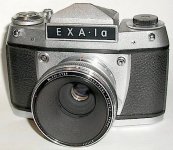
Exa 1a: This special half frame version made for the Royal Canadian Mounted Police has a 40mm f/2.8 Mark-Kilar lens for shooting closeups of evidence.
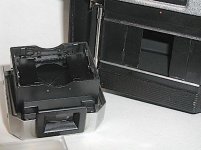
Back view of Exa 1a limited half frame edition for Royal Canadian Mounted Police shows camera and prism adapted for the 18 x 24mm format.
The regular full frame Exa 1b was produced from 1977-1985 by VEB Pentacon and some late examples were built by Certo Camera Werk, Dresden. The Exa 1b is virtually the same as the Exa 1a except for the nameplate, a rewind crank in place of a knob, and an M42 screw mount (with internal aperture coupling) instead of the traditional Exakta bayonet mount. Well, you guessed it—a small (unknown) number of these cameras were produced in a half frame version, probably for police use. The standard lens was a 50mm f/2.8 Mayer Domiplan. If you run into one of these beauties at a reasonable price you should probably grab it because they’re very rare, but I can’t vouch for their investment potential-
The Konica FT-1 Pro Half: Best Half Frame 35mm SLR You Can Buy?
The Konica FT-1 that debuted in 1983 is Konica’s last and best electronically controlled 35mm SLR and was the very last SLR Konica built under its own name. A motor wind SLR that can shoot at up to 2 fps in continuous mode, it features silicon photodiode controlled shutter priority metering, an electronically controlled metal blade vertical travel Copal focal plane shutter with speeds of 2-1/1000 sec plus B and X sync at 1/100 sec, and a bright, contrasty pentaprism viewfinder with a central split-image rangefinder surrounded by a microprism collar. It’s powered by four AAA alkaline batteries (no NiCads!) in the compact grip (or an optional larger AA grip). The FT-1 is quite compact given its impressive feature set, and it has a solid feel even though much of its outer body (there were chrome and black versions) is polycarbonate. Another attractive feature of the FT-1 is that it accepts the complete range of Konica AR-mount lenses, including such standouts as the Hexanon 40mm f/1.8 and 57mm f/1.2.
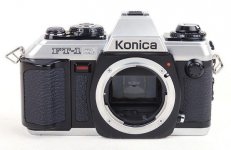
Konica FT-1 Pro Half: Note reflected full frame screen with vertical lines marking the 18 x 24mm format. This allows you to see areas beyond captured image!
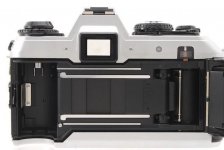
Open back view of Konica FT-1 Pro Half shows film gate aperture modified to provide 18 x 24mm half frame format.
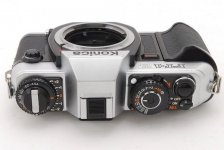
Top view of Konica FT-1 Pro Half. Controls are the same as the regular full frame Konica FT-1, but the viewfinder is marked to indicate the half frame format.
The FT Pro Half story
Well unbeknownst even to many Konica aficionados, there was and is a factory made half frame version of the Konica FT-1 called the Konica FT-1 Pro Half as indicated by a little silver “PRO HALF” sticker next to the nameplate. As you’d expect its film gate, finder, film advance mechanism, and frame counter have been modified to accommodate the 18 x 24mm format, but the viewfinder still covers the full frame 24 x36mm format and delineates the new format with 2 vertical black lines. This makes the Pro Half one of the only (maybe the only!) SLR viewfinder that lets you see things beyond the captured image on both sides, which can be advantageous when tracking action. The ability to see what’s happening outside the frame has long been one of the vaunted advantages of 35mm rangefinder cameras with multi-frame viewfinders—like Leica Ms, for example. How well does this all work in practice? To find out you’ll have to wait for my forthcoming hands-on review of the Konica FT-1 Pro Half. In the meantime, I can tell you that the Pro Half was produced in very small quantities (perhaps a few hundred), all in matte chrome finish, and they were never sold to the public or marketed through normal retail channels but were presented as special gifts to corporate customers and company executives. It’s certainly a collector’s prize. Indeed, as we go to post, there’s a mint “open box, body only” example listed on one of the leading online auction sites at a cool $1,399.99 plus $54.99 shipping!
but Japanese camera makers like Konica dominated the field
By Jason Schneider
Konica Auto-Reflex: Half Frame or Full Frame at the flick of a switch!
The Konica Auto-Reflex of 1966 (known as the Autorex in Japan) was the first truly successful auto-exposure SLR in the world in terms of its impact in the marketplace, and its mechanical reliability (the 1959 Savoyflex III from France was technically the first AE SLR, employing a Prontor leaf shutter and selenium-cell-controlled, shutter-priority metering system, but it was trouble prone and not very successful). What sometimes gets lost in the sauce is that Auto Reflex also has the remarkable ability to switch between full (24x36mm) and half-frame (18x24mm) formats at any time (!) a feature Konica pioneered in the Konica IIIM rangefinder camera in 1959. The Auto-Reflex has an external CdS cell to the right of the lens that controls a trap-needle type, shutter-priority autoexposure system, a feature of all Konica SLRs until the series finished in 1985. The Copal Square vertical travel metal focal-plane shutter provides speeds of 1/25-1/400 sec in automatic mode and 1-1/1000 sec in manual match-needle-metering mode, and the camera has a fixed pentaprism and a single stroke wind lever. Less than two years later, the Auto-Reflex evolved into the through-lens- (TTL) metering Autoreflex T, alas without the half frame option. The T was the camera that established Konica as a major SLR maker from the late ‘60s to the late ‘70s. Though it’s a historically important camera that is not too common in this country, the Konica Auto-Reflex is often quite reasonably priced when you find them, and they’ll accept all Konica AR bayonet-mount lenses. Approximate used price: Body only , $150-$175; with 52mm f/1.8 Konica Hexanon AR lens, $250.
 `
`Konica Autorex of 1965 with 52mm f/1.8 Hexanon lens. Sold as the Auto-Reflex in the U.S. it was the world's first focal plane shutter autoexposure SLR, but it was also unique in being able to switch between full frame and half frame format at any time. Note non-TTL external CdS cell in round housing on the front.
Alpa Half Frame Models
Alpa was the name used for a series of high-end 35mm SLRs virtually hand assembled by Pignons S.A., a small artisanal Swiss company that made pinions for the Swiss watch industry. Based on a pre-war design penned by Jacques Bogobolsky (aka Bolsky) who famously designed the 16mm Bolex movie camera and various Bolsey 35s, the Alpa had a reputation for elegance precision, and exclusivity. It featured a removable back, a horizontal cloth focal plane shutter with speeds of 1/1000 sec plus B, and a ratcheted front facing film advance lever that you grab from the front and swing to the right. Like the Exakta, the Alpa’s shutter release is in the front of the camera where it can be conveniently coupled to the lens to provide external auto aperture stop-down when you press the release. The Alpa 9d of 1964 introduced a pentaprism for eyelevel viewing. It was one if the first SLRs with built-in CdS TTL metering, and the first to position the meter cells on the sides the eyepiece, a solution adopted by most other SLR makers. Alpa made a total of 3710 9d’s in various finishes including a very small number of half frame units before production was discontinued in 1969. The half frame models were basically modified full frame models with their film apertures and viewfinders masked down for the smaller format, and their frame counters suitably modified

Front and rear views of half frame Alpa 9d. The post Swiss made 35mm SLRs were crafted in small quantities and half frame models are rare and pricey.
The Alpa 10d of 1968 added a non-rotating shutter speed dial, a second meter needle and index visible through a window in the accessory shoe, and other metering improvements. Out of the total production of 2540 10d’s 27 were made in half frame format before the model was phased out in 1974. The Alpa 11 series included 11 (!) minor variants. The Alpa IIe (with lighted metering arrows) commenced production in 1971 and was phased it out in 1975, with a total production of 1228 units, only 4 of which were half frame. The 11 el of 1972 (which indicated correct exposure by lighting up both metering arrows) had a total production run of 1163 units including 33 in half frame format when production ceased in 1976. Finally, the 11z, the last Swiss made Alpa (later Alpas, such as,the Si 2000, were made in Japan by Cosina) had a single shutter speed of 1/60 sec for electronic flash and a total production from 1977-1979 of 96 units, all in half frame format.

Alpa 11 z: The last Swiss made Alpa it was special a half frame model as you can see and it a single shutter speed of 1/60 sec. Only 96 were made!
All Swiss Alpas were turned out in very small quantities and perhaps no more than 40,000 were made in total. That’s why the half frame models are extremely rare and stratospherically priced, starting in the 5-figure range.
Alpa did not make its own lenses but Kern of Switzerland, Enna, Old Delft, Angenieux, Schneider, Schacht, and Kinoptic were happy to oblige. The Swiss Alpa was unusual in having a much shorter lens-to-film-plane (flange focal) distance than most 35mm SLRs, a key to its longevity and its optical flexibility.
Pentax half frame SLRs: One-off and production
Was there really a half frame Pentax? In fact, there were 2, but only one was manufactured entirely by Asahi Optical Co. The mysterious Pentax KX Half Frame was evidently a one-off modified KX, possibly created by a talented camera tech named Klinger. To quote from a May 2016 query posted on PentaxForums.com, “I snared this unicorn at the Pasadena Camera Show this past weekend; the seller got it from an estate sale on rubylane.com. It's got a modified film gate, masked-off viewfinder, a regeared film advance, and a handwritten 72-frame insert for the frame counter. Beneath the gate is inscribed MODIFIED BY KLINGER, and there are other inscriptions. Tell me what you know!” Well, to coin a phrase, “sjeffg” answered his own question, and to the best of my knowledge no further info on the camera’s provenance has emerged. For the record the Pentax KX, introduced in 1975, was a downsized bayonet mount TTL metering SLR with features paralleling those of the Pentax Spotmatic.

Pentax KX Half Frame: Yes, it exists and even has a nameplate, but it was evidently the work of a talented machinist and not a product of Asahi Optical Co,
The Pentax MF is the real thing, a genuine factory-made limited production half frame SLR loosely based on the Pentax ME that was evidently intended for medical imaging. To quote a Sept. 2009 posting on the Pentax Forums by Paul Ewins of Melbourne, Australia, “The Pentax MF and MF-1 are probably closer to the ME in features but are different enough to be their own thing. The most noticeable thing is the little hump on the prism where the hot shoe normally sits but as you can see from the top view the shutter speeds and exposure compensation are both different. As mentioned, they both have FP sync sockets. I have one MF with the data back pins and one without, so I don't know whether that was an option or a newer/later version. The MF is half frame, while the MF-1 is full frame and of course they have the same hump in the focusing screen as the MX Medical. And since the MF is half frame the frame counter has a 0, 4, 8, 12 sequence up to 72 instead of the usual sequence of 0, 2, 4 ,6… up to 36. The 0, 40, 48, and 72 are marked in orange instead of the usual 0, 20, 24 and 36.” The a,b,c,d and A,B,C,D exposure compensation scales and the “1/4 sec” setting on the exposure mode dial are, um, interesting, but since nobody has come up with a manual we can only surmise their exact functions.

Pentax MF half frame camera with original box; Loosely based on the best selling Pentax ME, it's very pretty and a collector's prize
For the record, the compact full frame Pentax ME introduced in 1976 was a very successful K-mount, aperture priority AE SLR with a vertical travel metal focal plane shutter with speeds from 8 to 1/1000 sec, and X sync at 1/100 sec There was no shutter dial, and the camera couldn’t be used in manual mode, except at the B and 1/100 sec settings. The ME provided TTL, open aperture, center-weighted metering that was activated by a slight pressure on the release button. How many Pentax MF half frame SLRs were made, and what are they worth? Hard figures are elusive, but I ‘d surmise that total production was in the low hundreds, and that selling prices would be in the low thousands.

Open back view of Pentax MF shows half frame 18 x 24mm film gate aperture, and ingenious multi-slotted take-up spool.

Pentax MF top view shows control array similar to full frame Pentax ME. Note odd "abcd ABCD" exposure compensation dial and "1/4" sec exposure mode.
The Praktica L2 half frame
This East Germany beauty was a half frame variant of the spartan meter-less Praktica L2 made in large quantities (161,240 cameras) from late 1975 to early 1980. It had the same basic features as the standard full frame L2, including an M42 screw mount, an easy loading system, fixed eyelevel pentaprism finder, instant return mirror and a single stroke wind lever. The half frame version of the L2, used mostly by police departments for shooting mug shots, has a single, fixed, X-sync shutter speed of 1/125 sec (unlike the full frame version whose mechanically controlled, vertical travel, metal focal plane shutter has speeds of 1-1/1000 sec plus B) a Fresnel finder screen with central microprism that was masked down to the 18 x 24mm format using black fabric (!), a modified rewind knob, and an auto-zeroing frame counter. The half frame L2 shown was fitted with a 50mm f/2,8 Meyer Domiplan lens (a mediocre triplet) and sold for a paltry 120 euros. Nobody knows for sure how many of these gems were produced, but production numbers were probably fairly low given the limited market and its single-speed shutter that would be off-putting to everyday shooters. You can snag a regular (quite nice) full frame Praktica L2 complete with sketchy Domiplan lens for around 75 bucks; a rare half frame L2 would probably run 3-4 times that.

Praktica L2: The standard full frame version had a single stroke wind lever but this half framer had a tall wind knob and a single 1/125 sec shutter speed.

Open back view of Praktica L2 half frame shows 18 x 24mm film gate aperture, vertical metal blade focal plane shutter, and quick loading take-up spool.
Half frame Exas? Yep!
The Exa 1a of 1964 added a wind lever, more modern styling licks, and a shutter speed dial (instead of a stick in a slot!) under the rewind knob to the Exakta’s little sister. However, its distinctive under the mirror “bread box” shutter with speeds of 1/30, 1/60, 1/125, and 1/175 sec plus B, Ekakta bayonet mount, and interchangeable waist level and prism finders remained the same. Well, it turns out that Ihagee Kamerawerk AG Dresden also supplied a small number of half frame, 18 x 24mm format Exa 1a cameras to, of all people, the Royal Canadian Mounted Police (RMCP). The prism and the film gate aperture were factory modified for viewing and shooting in the half frame format, and the winding mechanism and frame counter were recalibrated to provide and monitor 72 exposures per 36-exposure roll of 35mm film. The Canadian cops evidently used their half frame Exas to capture mug shots of suspects, but the image of the RMCP running around with half frame Exas in their saddlebags is too delicious to contemplate. The RMCP Exa 1a shown is fitted with a 40mm f/2.8 Makro-Kilar, so maybe they used it to shoot closeups as well. In any event it’s a rare camera and I can’t find any listed fir sale. My best price guess for an Exa 1a hald frame body: $500-$1,000.

Exa 1a: This special half frame version made for the Royal Canadian Mounted Police has a 40mm f/2.8 Mark-Kilar lens for shooting closeups of evidence.

Back view of Exa 1a limited half frame edition for Royal Canadian Mounted Police shows camera and prism adapted for the 18 x 24mm format.
The regular full frame Exa 1b was produced from 1977-1985 by VEB Pentacon and some late examples were built by Certo Camera Werk, Dresden. The Exa 1b is virtually the same as the Exa 1a except for the nameplate, a rewind crank in place of a knob, and an M42 screw mount (with internal aperture coupling) instead of the traditional Exakta bayonet mount. Well, you guessed it—a small (unknown) number of these cameras were produced in a half frame version, probably for police use. The standard lens was a 50mm f/2.8 Mayer Domiplan. If you run into one of these beauties at a reasonable price you should probably grab it because they’re very rare, but I can’t vouch for their investment potential-
The Konica FT-1 Pro Half: Best Half Frame 35mm SLR You Can Buy?
The Konica FT-1 that debuted in 1983 is Konica’s last and best electronically controlled 35mm SLR and was the very last SLR Konica built under its own name. A motor wind SLR that can shoot at up to 2 fps in continuous mode, it features silicon photodiode controlled shutter priority metering, an electronically controlled metal blade vertical travel Copal focal plane shutter with speeds of 2-1/1000 sec plus B and X sync at 1/100 sec, and a bright, contrasty pentaprism viewfinder with a central split-image rangefinder surrounded by a microprism collar. It’s powered by four AAA alkaline batteries (no NiCads!) in the compact grip (or an optional larger AA grip). The FT-1 is quite compact given its impressive feature set, and it has a solid feel even though much of its outer body (there were chrome and black versions) is polycarbonate. Another attractive feature of the FT-1 is that it accepts the complete range of Konica AR-mount lenses, including such standouts as the Hexanon 40mm f/1.8 and 57mm f/1.2.

Konica FT-1 Pro Half: Note reflected full frame screen with vertical lines marking the 18 x 24mm format. This allows you to see areas beyond captured image!

Open back view of Konica FT-1 Pro Half shows film gate aperture modified to provide 18 x 24mm half frame format.

Top view of Konica FT-1 Pro Half. Controls are the same as the regular full frame Konica FT-1, but the viewfinder is marked to indicate the half frame format.
The FT Pro Half story
Well unbeknownst even to many Konica aficionados, there was and is a factory made half frame version of the Konica FT-1 called the Konica FT-1 Pro Half as indicated by a little silver “PRO HALF” sticker next to the nameplate. As you’d expect its film gate, finder, film advance mechanism, and frame counter have been modified to accommodate the 18 x 24mm format, but the viewfinder still covers the full frame 24 x36mm format and delineates the new format with 2 vertical black lines. This makes the Pro Half one of the only (maybe the only!) SLR viewfinder that lets you see things beyond the captured image on both sides, which can be advantageous when tracking action. The ability to see what’s happening outside the frame has long been one of the vaunted advantages of 35mm rangefinder cameras with multi-frame viewfinders—like Leica Ms, for example. How well does this all work in practice? To find out you’ll have to wait for my forthcoming hands-on review of the Konica FT-1 Pro Half. In the meantime, I can tell you that the Pro Half was produced in very small quantities (perhaps a few hundred), all in matte chrome finish, and they were never sold to the public or marketed through normal retail channels but were presented as special gifts to corporate customers and company executives. It’s certainly a collector’s prize. Indeed, as we go to post, there’s a mint “open box, body only” example listed on one of the leading online auction sites at a cool $1,399.99 plus $54.99 shipping!
das
Well-known
Don't forget about the Konica Eye series! Also, why no one ever made a true rangefinder coupled half frame is crazy.
Don't forget about the Konica Eye series! Also, why no one ever made a true rangefinder coupled half frame is crazy.
"crazy" also inaccurate.
Jason Schneider
the Camera Collector
Don't forget about the Konica Eye series! Also, why no one ever made a true rangefinder coupled half frame is crazy.
The Konica Eye series was interesting and the top of the line had an f/1.9 lens but these all have inverse Galilean optical viewfinders and scale/zone focusing so none of them is a half frame SLR, which is the subject of my article. The Leica 72 was a half frame coupled rangefinder camera with interchangeable lenses. So was the Nikon S3M of 1960..
Pál_K
Cameras. I has it.
I have seen and handled this very camera - the workmanship and operation is excellent - if a person didn’t know this was a custom modification, it would appear to have come from Pentax itself.…
Pentax half frame SLRs: One-off and production
Was there really a half frame Pentax? In fact, there were 2, but only one was manufactured entirely by Asahi Optical Co. The mysterious Pentax KX Half Frame was evidently a one-off modified KX, possibly created by a talented camera tech named Klinger. To quote from a May 2016 query posted on PentaxForums.com, “I snared this unicorn at the Pasadena Camera Show this past weekend; the seller got it from an estate sale on rubylane.com. It's got a modified film gate, masked-off viewfinder, a regeared film advance, and a handwritten 72-frame insert for the frame counter. Beneath the gate is inscribed MODIFIED BY KLINGER, and there are other inscriptions. Tell me what you know!” Well, to coin a phrase, “sjeffg” answered his own question, and to the best of my knowledge no further info on the camera’s provenance has emerged. For the record the Pentax KX, introduced in 1975, was a downsized bayonet mount TTL metering SLR with features paralleling those of the Pentax Spotmatic.
Pentax KX Half Frame: Yes, it exists and even has a nameplate, but it was evidently the work of a talented machinist and not a product of Asahi Optical Co,
…
das
Well-known
The Konica Eye series was interesting and the top of the line had an f/1.9 lens but these all have inverse Galilean optical viewfinders and scale/zone focusing so none of them is a half frame SLR, which is the subject of my article. The Leica 72 was a half frame coupled rangefinder camera with interchangeable lenses. So was the Nikon S3M of 1960..
Sorry! I saw the Pen in the first article and got RFs stuck in my head for some reason.
I guess I meant to say a RF coupled half frame that is not some insanely rare, expensive, and out-of-reach collectors item.
The Konica Eye series was interesting and the top of the line had an f/1.9 lens but these all have inverse Galilean optical viewfinders and scale/zone focusing so none of them is a half frame SLR, which is the subject of my article. The Leica 72 was a half frame coupled rangefinder camera with interchangeable lenses. So was the Nikon S3M of 1960..
there were also some rangefinder half frame prototypes
the half frame Konica Hexar RF currently for sale on ebay at $6K or so
the half frame Konica Hexar AF - not a RF but close
the half frame Voigtlander Bessa R4A - four made.
Retro-Grouch
Well-known
Not to rain on the parade, but half-frame cameras mostly don't make sense to me. Most of the examples shown are full size cameras masked down to half frame; there goes any argument about reduced size and weight. And the financial savings afforded by double the number of frames per roll would have been negligible during film's heyday, though perhaps not so much now with our current film prices. The image quality is marginal despite the best lenses, as the sharpest detail gets overcome by grain. I have seen half-frame shots that work because of the grain, but for how many photographers is huge grain integral to the image at all times? Generally, half-frame seems like a solution in search of a problem.
The Pen F series, designed from the ground up for optimal size and weight, does make some limited sense. I could see their value to photojournalists, for example, or anyone who needed to travel light with minimal bulk. But it seems that they never caught on with photojournalists. Now, I must confess to having had twinges of GAS over the years for a Pen Fv. But like much of my GAS, it is based on an appreciation of the cameras' exquisite looks and engineering brilliance. I've never indulged those particular GAS attacks, and probably never will.
I do own half-frame cameras: when I want to minimize size and bulk, I take my Pentax 645 instead of the 6x9 Horseman.
The Pen F series, designed from the ground up for optimal size and weight, does make some limited sense. I could see their value to photojournalists, for example, or anyone who needed to travel light with minimal bulk. But it seems that they never caught on with photojournalists. Now, I must confess to having had twinges of GAS over the years for a Pen Fv. But like much of my GAS, it is based on an appreciation of the cameras' exquisite looks and engineering brilliance. I've never indulged those particular GAS attacks, and probably never will.
I do own half-frame cameras: when I want to minimize size and bulk, I take my Pentax 645 instead of the 6x9 Horseman.
shawn
Mentor
there were also some rangefinder half frame prototypes
the half frame Konica Hexar RF currently for sale on ebay at $6K or so
the half frame Konica Hexar AF - not a RF but close
the half frame Voigtlander Bessa R4A - four made.
All Konica IIIMs are full or half frame cameras.... if you still have the original half frame insert.
Shawn
Jason Schneider
the Camera Collector
Not to rain on the parade, but half-frame cameras mostly don't make sense to me. Most of the examples shown are full size cameras masked down to half frame; there goes any argument about reduced size and weight. And the financial savings afforded by double the number of frames per roll would have been negligible during film's heyday, though perhaps not so much now with our current film prices. The image quality is marginal despite the best lenses, as the sharpest detail gets overcome by grain. I have seen half-frame shots that work because of the grain, but for how many photographers is huge grain integral to the image at all times? Generally, half-frame seems like a solution in search of a problem.
The Pen F series, designed from the ground up for optimal size and weight, does make some limited sense. I could see their value to photojournalists, for example, or anyone who needed to travel light with minimal bulk. But it seems that they never caught on with photojournalists. Now, I must confess to having had twinges of GAS over the years for a Pen Fv. But like much of my GAS, it is based on an appreciation of the cameras' exquisite looks and engineering brilliance. I've never indulged those particular GAS attacks, and probably never will.
I do own half-frame cameras: when I want to minimize size and bulk, I take my Pentax 645 instead of the 6x9 Horseman.
To begin with, the thrust of the article was to explore the subject of half frame 35mm SLRs, a category that was a lot more numerous and varied that many people realized. I was not plumping for the half frame format nor extolling its virtues. Having said that, your bold assertion that, "The image quality is marginal despite the best lenses, as the sharpest detail gets overcome by grain," is way over the top. I have about two dozen 11 x 14 enlargements and even a few 16 x 20s made from half frame negatives (mostly on Tri-X and Plus-X) that show excellent detail and nice tonal gradation, and while the larger enlargements do show somewhat more grain than comparable images shot on full frame, they are by no means "overcome by grain." Half frame makes the most sense in scale focusing ultra-compact cameras like the original Olympus Pen of 1959, which was a minimalist pocket sized masterpiece, and the follow-up Olympus Pen S, which had an f/2.8 lens and a wider range if shutter speeds. Back in the day I also shot surreptitious pictures using spring wind Ricoh Auto Half in a chest-mounted rig made for me by the late great Marty Forscher. The Olympus Pen Fv was a lovely half frame SLR supported by an excellent line of Zuiko lenses and capable of first class results. The so-called Half Frame Craze lasted for well over a decade, and practically every major manufacturer got into the act, including Canon, Fuji, Konica, Yashica, Minolta, Ricoh, and Petri. You can't achieve that level of success based on wretched image quality.
To begin with, the thrust of the article was to explore the subject of half frame 35mm SLRs, a category that was a lot more numerous and varied that many people realized. I was not plumping for the half frame format nor extolling its virtues. Having said that, your bold assertion that, "The image quality is marginal despite the best lenses, as the sharpest detail gets overcome by grain," is way over the top. I have about two dozen 11 x 14 enlargements and even a few 16 x 20s made from half frame negatives (mostly on Tri-X and Plus-X) that show excellent detail and nice tonal gradation, and while the larger enlargements do show somewhat more grain than comparable images shot on full frame, they are by no means "overcome by grain." Half frame makes the most sense in scale focusing ultra-compact cameras like the original Olympus Pen of 1959, which was a minimalist pocket sized masterpiece, and the follow-up Olympus Pen S, which had an f/2.8 lens and a wider range if shutter speeds. Back in the day I also shot surreptitious pictures using spring wind Ricoh Auto Half in a chest-mounted rig made for me by the late great Marty Forscher. The Olympus Pen Fv was a lovely half frame SLR supported by an excellent line of Zuiko lenses and capable of first class results. The so-called Half Frame Craze lasted for well over a decade, and practically every major manufacturer got into the act, including Canon, Fuji, Konica, Yashica, Minolta, Ricoh, and Petri. You can't achieve that level of success based on wretched image quality.
Agreed! One of my first cameras was a small Petri Half-7 purchased in the early-1960's for $28 from the store at a NATO airbase near Izmir Turkey. That camera gave satisfying results for a number of years until I loaned it to a friend on temporary duty in the Philippines and it was stolen. It had full focus range with click-stops at common distances each bringing up a relevant symbol in the viewfinder -- a single head for close portraits, a group of people to indicate that subject, and finally a mountain range for scenic shots. I still have the Pen FT handed down from my father, plus a second FT and a Pen Fv that has had the self-timer lever nicely machined off for some unknown usage. This is fine gear.
das
Well-known
To begin with, the thrust of the article was to explore the subject of half frame 35mm SLRs, a category that was a lot more numerous and varied that many people realized. I was not plumping for the half frame format nor extolling its virtues. Having said that, your bold assertion that, "The image quality is marginal despite the best lenses, as the sharpest detail gets overcome by grain," is way over the top. I have about two dozen 11 x 14 enlargements and even a few 16 x 20s made from half frame negatives (mostly on Tri-X and Plus-X) that show excellent detail and nice tonal gradation, and while the larger enlargements do show somewhat more grain than comparable images shot on full frame, they are by no means "overcome by grain." Half frame makes the most sense in scale focusing ultra-compact cameras like the original Olympus Pen of 1959, which was a minimalist pocket sized masterpiece, and the follow-up Olympus Pen S, which had an f/2.8 lens and a wider range if shutter speeds. Back in the day I also shot surreptitious pictures using spring wind Ricoh Auto Half in a chest-mounted rig made for me by the late great Marty Forscher. The Olympus Pen Fv was a lovely half frame SLR supported by an excellent line of Zuiko lenses and capable of first class results. The so-called Half Frame Craze lasted for well over a decade, and practically every major manufacturer got into the act, including Canon, Fuji, Konica, Yashica, Minolta, Ricoh, and Petri. You can't achieve that level of success based on wretched image quality.
Agreed as well. I wonder how much of the half-frame craze may have been driven by film & processing prices during the era, or whether that was not really a factor in the popularity. Also, did photo labs charge *more" to print a roll of 72 half-frame photos as opposed to 36? In an era of 3x5 and 4x6 prints, those enlargements are really not big enough for lens quality to matter as much.
Mackinaw
Think Different
.....I have seen half-frame shots that work because of the grain, but for how many photographers is huge grain integral to the image at all times? .....
That's how I often use my half-frame camera, for the grain. I picked up a broken Canon Dial-35 for a pittance, fixed it (spring-powered motor drive needed some oil), and use it on model shoots. With Eastman 5222-XX loaded, I get the most interesting images.
JIm B.
Share:
-
This site uses cookies to help personalise content, tailor your experience and to keep you logged in if you register.
By continuing to use this site, you are consenting to our use of cookies.

